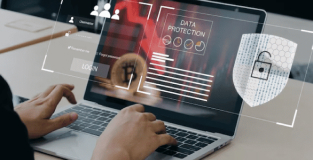The Future of SaaS Security: Building Trust and Resilience in the Cloud

Introduction
Cloud-based software (SaaS) is booming! Easy deployment, scalability, and cost-effectiveness make it a tempting option for businesses of all sizes. But hold on – security concerns might be giving you pause. Is your data truly safe up there in the cloud?
This blog post dives into the security landscape of SaaS applications. We'll explore how providers address your concerns and highlight the benefits of a security-focused SaaS bundle. Let's ensure your SaaS journey isn't clouded by security worries!
Understanding the Security Landscape of SaaS
SaaS applications operate on remote servers managed by the provider. While this offers convenience, it also raises concerns about data privacy, access control, and potential vulnerabilities. Let's delve deeper into some of the most prominent SaaS security concerns and explore potential solutions:
1. Data Breaches: The Looming Shadow
Data breaches are a constant threat in today's digital world, and SaaS applications aren't immune. These breaches can expose a treasure trove of sensitive information, putting both your customers and your business at risk.
- Customer Data:
Names, addresses, phone numbers, email addresses, and even financial data can be compromised, leading to identity theft and financial losses.
- Business Information:
Proprietary data, trade secrets, intellectual property, and internal communications can be targeted by competitors or malicious actors, causing significant financial and reputational damage.
- Research Highlights the Threat:
“A 2023 IBM Security report found that data breaches cost businesses an average of $4.35 million globally, highlighting the substantial financial impact of such incidents.”Breaches Beyond the Headlines: A web application vulnerability allowed hackers to steal the Social Security numbers and personal information of over 147 million Americans from Equifax, a major credit reporting agency. This incident highlights the vulnerability of SaaS applications and the severe consequences of data breaches, including reputational damage and potential identity theft for millions."SaaS security is a shared responsibility, While providers have a duty to implement robust security measures, businesses must also prioritize data protection by choosing the right solutions and fostering a culture of security awareness." - says Kevin Mitnick, a renowned cybersecurity expert.
- Mitigating the Risk:
- Encryption is Paramount: Robust encryption of data, both at rest and in transit, is essential. This scrambles data into an unreadable format, rendering it useless even if intercepted by unauthorized parties.
- Multi-Factor Authentication (MFA): Implementing MFA adds an extra layer of security by requiring a secondary verification step beyond just a username and password. This significantly reduces the risk of unauthorized access in case of compromised credentials.
- Regular Security Audits: Partnering with a SaaS provider that conducts regular penetration testing and vulnerability assessments is crucial. These proactive measures identify weaknesses in the system's security posture before they can be exploited by attackers.
Unauthorized Access: A Persistent Threat
Inadequate access controls can leave the door wide open for unauthorized users to gain access to sensitive data within a SaaS application. This can happen through various means, such as:
- Weak Password Management:
Employees reusing passwords across different platforms or using easily guessable passwords creates vulnerabilities.
- Insider Threats:
Disgruntled employees or those with compromised accounts can pose a significant risk of data exfiltration.
- Social Engineering Attacks:
Cunning attackers may use phishing emails or other social engineering tactics to trick employees into revealing login credentials.
1. The Cost of Inadequate Access Control
“ A 2022 Verizon Data Breach Investigations Report indicated that 82% of data breaches involved a human element, underlining the importance of access control measures.”
Securing the Gates
- Role-Based Access Control (RBAC): Grant access only to what users need for their jobs.
- Strong Password Policies: Enforce complex passwords and regular changes to minimize brute-force attacks.
- Security Awareness Training: Educate employees on cybersecurity best practices to avoid falling victim to scams.

Compliance Challenges: A Regulatory Maze
Depending on your industry, you might be subject to a complex web of regulations regarding data security and privacy. SaaS environments can make navigating these regulations, particularly challenging due to:
- Data Residency:
Understanding where your data is stored and processed by the SaaS provider is crucial for compliance with regulations like GDPR (General Data Protection Regulation) that govern data residency requirements.
- Data Security Standards:
Adhering to industry-specific data security standards like HIPAA (Health Insurance Portability and Accountability Act) or SOC 2 (Service Organization Controls) can be complex in a SaaS environment. This complexity arises from the lack of complete control over the underlying infrastructure used by the SaaS provider. ISO 27001 offers a framework to build a compliant information security program, achieving compliance with specific regulations like HIPAA within a SaaS environment.
- The Compliance Conundrum:
“ A 2021 survey by TrustRadius found that 61% of businesses struggle with data privacy compliance, highlighting the complexities involved. “
- Charting the Course:
- Transparency is Key: Choose a SaaS provider that offers clear and transparent information about their data security practices, data residency locations, and compliance certifications.
- Compliance Assistance: Achieve multi-layered security and compliance with audits, SaaS tools, and industry expertise. Invimatic streamlines processes by handling questionnaires, and audits, and enforcing security protocols in development and operations, freeing your team to focus on core security tasks.
- Regular Reviews: Review the SaaS provider's security posture and compliance certifications to ensure they align with your evolving needs.
The Power of Integrations
SaaS applications often rely on Application Programming Interfaces (APIs) to integrate with other systems and exchange data. However, these APIs can introduce security vulnerabilities if not properly managed. Here's a breakdown of the specific integration risks associated with SaaS:
- Secure APIs:
The foundation of strong integrations starts by following secure coding practices and proper authentication/authorization protocols which can eliminate vulnerabilities that expose sensitive data or allow manipulation
- Limited Visibility:
When integrating with multiple SaaS applications, it can be challenging to maintain complete visibility into all API interactions. This lack of oversight can make it difficult to detect and respond to potential security threats promptly.
- Securing the Integration Landscape:
- API Security Best Practices: Choose a SaaS provider that adheres to industry best practices for API security, such as implementing strong authentication and authorization mechanisms for API calls, and regularly monitoring API activity for suspicious behavior.
- API Gateway Implementation: Consider deploying an API gateway to manage and secure all API interactions within your SaaS ecosystem. This allows for centralized access control, monitoring, and logging of API activity.
- Least Privilege Principle: Follow the principle of least privilege when configuring API integrations. Grant only the minimum permissions necessary for each API call to minimize the potential damage if a breach occurs.

- Research Backs the Threat:
"A recent study by Positive Technologies revealed a staggering 434% increase in API security incidents over the past three years, This highlights the critical need for businesses to understand and address the security risks associated with API integrations"- warns Michelle Paterson, a security researcher specializing in cloud-based systems.
The Power of a Security-Focused SaaS Bundle
While the measures mentioned above offer a strong foundation, a comprehensive security approach requires more. Here's where a security-focused SaaS bundle comes into play.
These bundles go beyond basic security features by offering additional functionalities like:
These bundles go beyond basic security features by offering additional functionalities like:
- Single Sign-On (SSO):
SSO simplifies user authentication by allowing access to multiple applications with a single login, reducing the risk of password fatigue and compromised credentials.
- Advanced Threat Detection:
These systems monitor user activity and network traffic for suspicious behavior, proactively identifying and mitigating potential security threats.
- Data Loss Prevention (DLP):
DLP solutions prevent sensitive data from being accidentally or intentionally shared outside authorized channels.
- Regulatory Compliance Assistance:
Security-focused bundles may offer tools and support to navigate complex compliance requirements specific to your industry.By choosing a security-focused SaaS bundle, businesses gain a multi-layered defense against security threats. This not only protects sensitive data but also fosters trust with customers who value their privacy.
Key Takeaways
RPA provides a transformative solution for healthcare providers aiming to enhance efficiency, cut costs, and deliver superior patient care. By thoughtfully evaluating the key considerations, healthcare organizations can make well-informed decisions about adopting RPA. Invimatic, with its proven expertise in RPA and comprehensive knowledge of the healthcare sector, is a trusted partner in this digital transformation. Our industry-specific solutions, combined with scalability, security, and outstanding support, empower your staff and maximize the benefits of RPA in your healthcare organization.
Allow us to lead you toward a future of streamlined workflows, empowered staff, and exceptional patient care.
Related Blogs

SaaS Application
Oct 25, 2024
The Ultimate Guide to SOC 2 Compliance for SaaS Companies

SaaS Application
Aug 13, 2023
SaaS applications on SOC 2 compliance

SaaS Application
Aug 07, 2023
